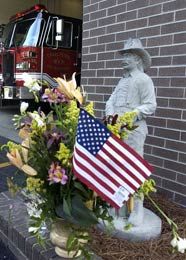 AP Photo/Stephen Morton Flowers are left outside a Charleston firehouse after the fire. |
A year ago this week, I dedicated my column to the Charleston 9 as they became known. Nine individuals who went to work to serve their community as they had done so many times in the past. Clearly they had no desire to die that fateful day, nor a desire to leave a legacy. But that’s what has occurred — and we are left to wonder how we deal with the tragedy.
We each have a responsibility to learn from each tragedy and near miss. A responsibility to ensure that we do all within our power — no matter how limited we may feel — to avert such a fate for the fellow firefighters we care about. We cannot justly recognize their loss and legacy unless we make such efforts every day.
As we look at some of the key factors from the Charleston Sofa Super Store fire, we should do so with the knowledge that these are not simply issues for Charleston, South Carolina. These issues can and do plague communities across this country and across the globe.
In many firehouses, the terms regulation, safety standards and best practices are met with a disapproving grunt. The reality is no department can, nor should, cast these items aside. Most fire departments in this country do not see enough fires to have their own “style” of firefighting; the use of regulations, standards and best practices allows us to learn from others mistakes. Although this can be a daunting process, the use of Standard Operating Procedures based on national standards helps protect firefighters as well as the citizens and property of our communities.
Different buildings
The buildings my grandfather and father entered as firefighters are different than those we enter today and we must come to terms with that. Construction of “disposable” buildings makes aggressive interior attacks useless where no life hazard is present. We didn’t make this situation, society did. If building owners decided it was acceptable to change the construction of the buildings we’ve sworn to protect, then it’s all right for us to rethink how we protect them.
These same buildings rapidly deteriorate, and the fire spread is unlike what we see in Type III or Type V residential construction. The control of information and personnel demands the use of an incident command system. Not only do chief officers need to ensure such systems are put in place, line officers and firefighters have to expect them to be there and support their use for our own safety. A chief who establishes/uses a strong ICS system only to have his crews bypass the process will be less likely to use the system the next time. We can help ensure that our chiefs use and stick to the system by using it ourselves. Stop freelancing, report to staging, report to operations/sector commanders.
The fire service, thankfully, is made up of individuals who want to do something. In many departments we try to encourage and support that feeling, which is not a bad thing. At the same time it is very easy for each of us to get focused on the problem we see, and lose the big picture. It is only through training, experience, education and re-evaluation that we are able to grow so that we learn not to be fooled by what we see.
I often tell people that if their “gut” tells them something is wrong, it probably is and you probably need to reconsider your actions. If the task isn’t working, we need to tell command so that they know that tactic is likely to fail and the strategy likely needs changing as well. Although personal ownership of a task is laudable in most cases, in our industry it can get you killed.
We also have to ensure that we bring enough people to the fight. Again our tactics and task have to match a strategy, a strategy that can only be established by those same tactics and tasks. If we don’t have enough firefighters on the ground, then we need to change our strategies.
Ultimately we each have an opportunity to have a legacy. We can do it through training, support and our general efforts. Perhaps the best legacy we can leave can be found in each of our firefighters who safely end the day.












